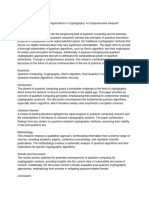0% found this document useful (0 votes)
45 views1 pageApplications of Quantum Computing in Cryptography
Quantum computing poses significant risks to traditional cryptography, particularly through algorithms like Shor’s and Grover’s, which can break RSA and weaken AES security. In response, the development of post-quantum cryptography, including lattice-based and code-based methods, is essential for securing digital communications. The paper emphasizes the need for proactive transitions to quantum-resistant techniques to protect future digital infrastructure.
Uploaded by
snowstreet5152Copyright
© © All Rights Reserved
We take content rights seriously. If you suspect this is your content, claim it here.
Available Formats
Download as TXT, PDF, TXT or read online on Scribd
0% found this document useful (0 votes)
45 views1 pageApplications of Quantum Computing in Cryptography
Quantum computing poses significant risks to traditional cryptography, particularly through algorithms like Shor’s and Grover’s, which can break RSA and weaken AES security. In response, the development of post-quantum cryptography, including lattice-based and code-based methods, is essential for securing digital communications. The paper emphasizes the need for proactive transitions to quantum-resistant techniques to protect future digital infrastructure.
Uploaded by
snowstreet5152Copyright
© © All Rights Reserved
We take content rights seriously. If you suspect this is your content, claim it here.
Available Formats
Download as TXT, PDF, TXT or read online on Scribd
/ 1

























































